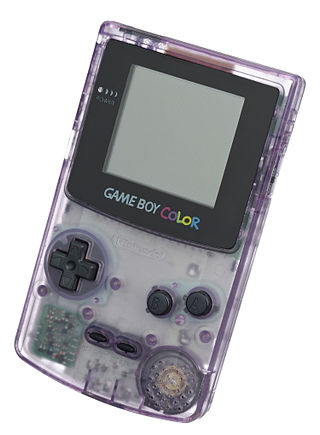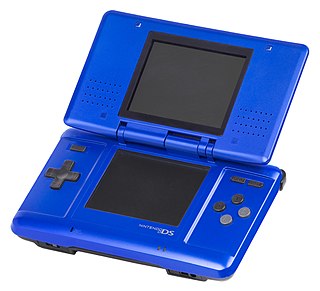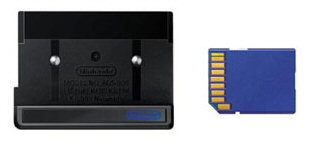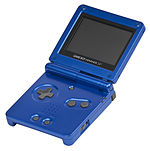
The Game Boy Color is an 8-bit handheld game console, manufactured by Nintendo, which was released in Japan on October 21, 1998, and to international markets that November. It is the successor to the Game Boy and is part of its product line. Compared to the original, the Game Boy Color features a color TFT screen rather than monochrome, a processor that operates twice as fast, and has four times as much memory. It retains backward compatibility with games initially developed for its predecessor. However, despite these improvements, reviewers consider the Game Boy Color an evolution rather than a revolutionary leap in handheld gaming technology.

A handheld game console, or simply handheld console, is a small, portable self-contained video game console with a built-in screen, game controls and speakers. Handheld game consoles are smaller than home video game consoles and contain the console, screen, speakers, and controls in one unit, allowing players to carry them and play them at any time or place.

The Game Boy Advance SP, released in Japan on February 14, 2003, is a sixth-generation handheld game console developed, released, and marketed by Nintendo that served as an upgraded version of the original Game Boy Advance. The "SP" in the name stands for "Special". It is the penultimate console in the Game Boy Advance product line before the Game Boy Micro, which was released in September 2005.

The Nintendo e-Reader, commonly abbreviated as e-Reader, is an add-on manufactured by Nintendo for its Game Boy Advance handheld video game console. It was released in Japan in December 2001, with a North American release following in September 2002. It has an LED scanner that reads "e-Reader cards", paper cards with specially encoded data printed on them.

The Game Boy Player (DOL-017) is a GameCube peripheral developed by Nintendo which enables it to play Game Boy, Game Boy Color, and Game Boy Advance cartridges, allowing those games to be played on a television.

The Nintendo DS is a foldable handheld game console produced by Nintendo, released globally across 2004 and 2005. The DS, an initialism for "Developers' System" or "Dual Screen", introduced distinctive new features to handheld games: two LCD screens working in tandem, a built-in microphone and support for wireless connectivity. Both screens are encompassed within a clamshell design similar to the Game Boy Advance SP. The Nintendo DS also features the ability for multiple DS consoles to directly interact with each other over Wi-Fi within a short range without the need to connect to an existing wireless network. Alternatively, they could interact online using the now-defunct Nintendo Wi-Fi Connection service. Its main competitor was Sony's PlayStation Portable during the seventh generation of video game consoles.

The Rumble Pak is a removable device from Nintendo that provides force feedback while playing video games. Games that support the Rumble Pak cause it to vibrate in select situations, such as when firing a weapon or receiving damage, to immerse the player in the game. Versions of the Rumble Pak are available for the Nintendo 64, the Nintendo DS, and the Nintendo DS Lite. A select few Game Boy Color and Game Boy Advance (GBA) games use a similar technology built into the game cartridge. Force feedback vibration has become a built-in standard feature in almost every home video game console controller since.
Game Pak is the brand name for ROM cartridges designed by Nintendo for some of their earlier video game systems. The "Game Pak" moniker was officially used only in North America, Europe, and Oceania. In Japan, Nintendo uses the term Cassette when referring to Famicom, Super Famicom and Nintendo 64 game paks, and Cartridge for the Game Boy line and Virtual Boy.

The GameCube Game Boy Advance cable (DOL-011) is a video game accessory manufactured by Nintendo which is used to connect the Game Boy Advance (GBA) handheld console to the GameCube (GCN) home console. Depending on the games it is used with, the cable may facilitate transferring data between related games, unlocking additional content, or turning the GBA into a controller or second screen.
Game Boy Advance Video is a format for putting full color, full-motion videos onto Game Boy Advance ROM cartridges. These videos are playable using the Game Boy Advance system's screen and sound hardware. They were all published by Majesco Entertainment, except for the Pokémon Game Boy Advance Video cartridges, which were published by Nintendo. Most cartridges were developed by DC Studios, Inc., except for the few labelled "Movie Pak" which were developed by 4Kids Entertainment's subsidiary 4Kids Technology, Inc. The video cartridges are colored white for easy identification and are sold as Game Boy Advance Video Paks; these offer the same 240×160 resolution as standard Game Boy Advance games, except for the Shrek and Shark Tale pack, which is at 112p.

WarioWare: Twisted! is a video game for the Game Boy Advance, developed by Nintendo SPD with Intelligent Systems and published by Nintendo. It was released on October 14, 2004 in Japan; May 19, 2005 in Australia; and May 23, 2005 in North America. The second game in the WarioWare series and the seventh in the Wario series overall, Twisted! was the last Wario game to be released on a Game Boy family system.

The Play-Yan is a media player designed for the Game Boy Advance SP and also compatible with the Game Boy Micro and Nintendo DS. It uses SD flash memory to play MP3 audio files and H.264/MPEG-4 AVC video files. It can also play 13 bonus mini-games, all of which are available freely on the Nintendo website in Japan. Sales of the Play-Yan were discontinued on September 11, 2005.
The Virtual Console is a defunct line of downloadable video games for Nintendo's Wii and Wii U home video game consoles and the Nintendo 3DS family of systems.

The Game Boy Advance Wireless Adapter is a wireless adapter accessory for the Game Boy Advance, released by Nintendo in 2004. It provides an alternative to the Game Boy Advance Game Link Cable but is only supported by a small number of games. The Game Boy Advance Wireless Adapter is also compatible with the Game Boy Advance SP, Game Boy Player, and e-Reader.

The Nintendo Game Link Cable is an accessory for the Game Boy line of handheld video game systems, allowing players to connect Game Boys of all types for multiplayer gaming. Depending on the games, a Game Link Cable can be used to link two games of the same title, like Tetris, or two compatible games like Pokémon Red and Blue. Games can be linked for head-to-head competition, cooperative play, trading items, unlocking hidden features, etc.
This is a list of video game accessories that have been released for the Game Boy handheld console and its successors. Accessories add functionality that the console would otherwise not have.

A ROM cartridge, usually referred to in context simply as a cartridge, cart, or card, is a replaceable part designed to be connected to a consumer electronics device such as a home computer, video game console or, to a lesser extent, electronic musical instruments.

The Japanese multinational consumer electronics company Nintendo has developed seven home video game consoles and multiple portable consoles for use with external media, as well as dedicated consoles and other hardware for their consoles. As of September 30, 2021, in addition to Nintendo Switch, Nintendo has sold over 863.07 million hardware units.
A Wireless game adapter is a device that, once connected to a video game console or handheld, enables internet and\or multiplayer access.




















